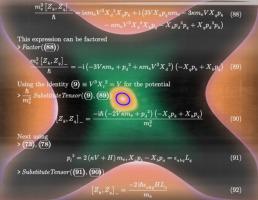Computer Physics Communications ( IF 6.3 ) Pub Date : 2021-06-30 , DOI: 10.1016/j.cpc.2021.108076 Pascal Szriftgiser , Edgardo S. Cheb-Terrab

|
Pauli first noticed the hidden SO(4) symmetry for the hydrogen atom in the early stages of quantum mechanics [1]. Starting from that symmetry, one can recover the spectrum of a spinless hydrogen atom and the degeneracy of its states without explicitly solving Schrödinger's equation [2], [3]. In this paper, we derive that SO(4) symmetry and spectrum using a computer algebra system (CAS). While this problem is well known [4], [5], its solution involves several steps of manipulating expressions with tensorial quantum operators, including simplifying them by taking into account a combination of commutator rules and Einstein's sum rule for repeated indices. Therefore, it is an excellent model to test the current status of CAS concerning this kind of quantum-and-tensor-algebra computations and to showcase the CAS technique. Generally speaking, when capable, CAS can significantly help with manipulations that, like non-commutative tensor calculus subject to algebra rules, are tedious, time-consuming and error-prone. The presentation also shows two alternative patterns of computer algebra steps that can be used for systematically tackling more complicated symbolic problems of this kind.
Program summary
Program Title: Maple specific worksheet
CPC Library link to program files: https://doi.org/10.17632/knbckjrwfc.1
Developer's repository link: https://www.maplesoft.com/applications/view.aspx?SID=154764
Licensing provisions: GPLv3
Programming language: Maple (Maplesoft)
Nature of problem: Provide a general framework to handle Quantum Mechanics' non-commutative algebra systematically. Non-commutative tensor calculus, subject to algebra rules, is tedious, time-consuming and error-prone. This Maple worksheet provides a general framework to implement, test and address a wide range of non-commutative problems commonly found in advanced quantum mechanics. It can be customized and adapted to potentially more complicated algebra problems.
Solution method: Make use of Maple's Physics package. First, configure the problem parameters: space dimension, tensor objects and non-commutative quantities. Then provide the most basic commutation rules, such as position, linear and angular momentum commutators. From there, using the Simplify command and a short set of other key commands, demonstrate further commutation rules until the complete target algebra is reconstructed. One should notice that the Physics package commands employed here take into account custom algebra rules, the sum rule for repeated indices, and use tensor-simplification algorithms.
Additional comments including restrictions and unusual features: This article mirrors a Maple worksheet. As such, it is not an usual code intended to make a computation for a given set of parameters. It is rather a general template or guideline, useful to extend the present problem with new computations or, more generally, widely open to tackle new quantum mechanics problem involving tensor and commutator heavy calculus.
中文翻译:

物理学中的计算机代数:氢原子的隐藏 SO(4) 对称性
在量子力学的早期阶段,泡利首先注意到氢原子隐藏的 SO(4) 对称性[1]。从这种对称性出发,无需明确求解薛定谔方程 [2]、[3],就可以恢复无自旋氢原子的光谱及其状态的简并性。在本文中,我们使用计算机代数系统 (CAS) 推导出 SO(4) 对称性和频谱。虽然这个问题是众所周知的[4], [5],其解决方案涉及使用张量量子算子操作表达式的几个步骤,包括通过考虑交换器规则和爱因斯坦重复索引求和规则的组合来简化它们。因此,它是一个很好的模型,可以测试 CAS 在这种量子和张量代数计算方面的现状,并展示 CAS 技术。一般来说,如果有能力,CAS 可以极大地帮助处理诸如受代数规则约束的非交换张量微积分等繁琐、耗时且容易出错的操作。该演示文稿还展示了计算机代数步骤的两种替代模式,可用于系统地解决此类更复杂的符号问题。
程序概要
程序名称: Maple 特定工作表
CPC 库程序文件链接: https : //doi.org/10.17632/knbckjrwfc.1
开发者仓库链接: https : //www.maplesoft.com/applications/view.aspx?SID=154764
许可条款: GPLv3
编程语言: Maple(Maplesoft)
问题性质:提供一个通用框架来系统地处理量子力学的非交换代数。受代数规则约束的非交换张量微积分是乏味、耗时且容易出错的。这个 Maple 工作表提供了一个通用框架来实现、测试和解决高级量子力学中常见的各种非交换问题。它可以定制并适应潜在更复杂的代数问题。
解决方法:利用Maple的Physics包。首先,配置问题参数:空间维度、张量对象和非交换量。然后提供最基本的换向规则,如位置、线性和角动量换向器。从那里开始,使用 Simplify 命令和一组简短的其他关键命令,演示进一步的交换规则,直到重建完整的目标代数。应该注意到这里使用的 Physics 包命令考虑了自定义代数规则、重复索引的求和规则,并使用了张量简化算法。
包括限制和不寻常功能在内的其他评论:本文反映了 Maple 工作表。因此,它不是用于对给定参数集进行计算的常用代码。它是一个通用的模板或指南,有助于用新的计算扩展当前的问题,或者更一般地说,广泛地用于解决涉及张量和换向器重微积分的新量子力学问题。



























 京公网安备 11010802027423号
京公网安备 11010802027423号